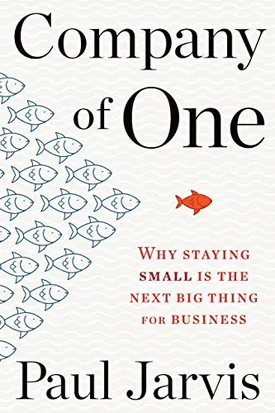Company of One: Why Staying Small Is the Next Big Thing for Business by Paul Jarvis
In Company of One: Why Staying Small Is the Next Big Thing for Business by Paul Jarvis, the author focuses on the idea of being a "company of one" and why this type of business model can be favorable for entrepreneurs and businesses. Jarvis explains the benefits of shunning fast growth, minimizing risk, and finding a balance between work and life. He also describes why staying small may be the best option, in terms of lifestyle and potential profits.
Jarvis begins by exploring the myth of fast-paced growth and the belief that growth means success. Drawing from his own experience, he relays how he grew his first business from a side gig in a rented warehouse, to a web design agency with 10 employees and clients all over the world. After living "the hyper growth bug", as he calls it, Jarvis says that it was a hamster wheel he couldn't really get off.
After reflecting on the intense and all-encompassing "growth unicorn", he opted for the path of staying small, and quickly realized that there are numerous benefits associated with owning a "one person business". He remarked, "big companies have their place, but small ones often have significant advantages: they can be nimble, efficient, and full of individuals who truly understand all areas of their business".
Jarvis then dives into the benefits of staying small. For example, he reasons that staying small drastically reduces risk and eliminates the need to constantly monitor cash flow. By diminishing overhead and staying away from investments, firms and entrepreneurs can start making profits faster. He also explains that a company of one is the ideal situation for neophyte entrepreneurs and those with a vision. By keeping the organization limited, individuals can have full ownership of the product and all decisions.
Jarvis moves into a discussion of how life and work balance is easier with a smaller operation. He explains how it is easier to manage one’s time when there is less structure, less paperwork and less responsibility. A company of one does not require an entrepreneur to add additional resources. "Your success involves working smarter, not necessarily longer," writes Jarvis.
When Jarvis delves into the topic of profits and longevity, he points out that small businesses have just as much of an opportunity to make a profit as larger businesses. However, he goes on to explain that one of the most important aspects of success for a company of one is understanding that it may be a short term project with a definite outset. For entrepreneurs wishing to stay in business for a long time but not wanting to expand like other companies, Jarvis points to the potential of replicating the model in order to stay “in the picture”.
In conclusion, Company of One: Why Staying Small Is the Next Big Thing for Business by Paul Jarvis is a guide for entrepreneurs to understand the potential of staying small and why this can be an advantageous business model. Jarvis gives evidence that staying small can help with risk reduction and staying profitable while finding a balance between work and life. He gives insight into the potential of scaling the company up temporarily, to stay successful and profitable for the long haul.

